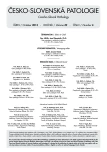How to improve the histopathological diagnosis of hepatocellular benign affections (adenoma versus focal nodular hyperplasia) in daily practice?
Authors:
Eva Honsová 1; Alena Lodererová 1; Halima Gottfriedová 2
Authors place of work:
Pracoviště klinické a transplantační patologie, Transplantcentrum IKEM, Praha
1; Klinika hepatogastroenterologie, Transplantcentrum IKEM, Praha
2
Published in the journal:
Čes.-slov. Patol., 49, 2013, No. 4, p. 149-152
Category:
Přehledový článek
Summary
Adenomas of the liver and focal nodular hyperplasia (FNH) are benign hepatocellular affection and their distinguishing in a needle biopsy sample and sometimes also in a surgical specimen causes often a problem. Although it might seem that the differentiation of the benign conditions is of a low value for the clinicians and also for the patients, the opposite is true. The risk of life-threatening bleeding and risk of the malignant transformation of adenomas leads to request accurate diagnosis of these conditions. New genetic methods followed by immunohistochemical detection of several antigens enables more accurate distinction not only of the two main groups of FNH and adenomas, but allows also to distinguish subsets of adenomas with varying risk of malignant transformation. Therefore, to determine the subtype of adenoma represents now essential part of a biopsy diagnosis. Identification of the subsets of adenomas allows an individualized treatment with resection in high-risk forms and, on the other hand, allows avoiding liver resection in the case of small liver mass with a low risk of malignant transformation.
Keywords:
liver adenoma – FNH – histopathology – malignant transformation
Zdroje
1. Bioulac-Sage P, Laumonier H, Couchy G, et al. Hepatocellular adenoma management and phenotypic classification: the Bordeaux experience. Hepatology 2009; 50 : 481-489.
2. Rebouissou S, Bioulac-Sage P, Zucman-Rossi J. Molecular pathogenesis of focal nodular hyperplasia and hepatocellular adenoma. J Hepatol 2008; 48 : 163-170.
3. Ehrmann J. Novinky v hepatopatologii. Cesk Patol 2013; 49 : 24.
4. Wanles IR, Mawdsley C, Adams R. On the pathogenesis of focal nodular hyperplasia of the liver. Hepatology 1985; 5 : 1194-1200.
5. Baum JK, Bookstein JJ, Holtz F et al. Possible association between benign hepatomas and oral contraceptives. Lancet 1973; 2 : 926-929.
6. Bioulac-Sage P, Cubel G, Balabaud C, Zucman-Rossi J. Revisiting the pathology of resected benign hepatocellular nodules using new immunohistochemical markers. Seminars in Liver Disease 2011; 31 : 91–103.
7. S. Van Der Borght, L. Libbrecht, A. Katoonizadeh et al. Nuclear β-catenin staining and absence of steatosis are indicators of hepatocellular adenomas with an increased risk of malignancy. Histopathology 2007; 51 : 855–856.
8. Evason K, Grenert J, Ferrell L, Kakar S. Atypical hepatocellular adenoma-like neoplasms with β-catenin activation show cytogenetic alterations similar to well-differentiated hepatocellular carcinomas. Hum Pathol 2013; 44(5): 750-758.
9. Wanless IR, Gryfe A. Nodular transformation of the liver in hereditary hemorrhagic telangiectasia. Arch Pathol Lab Med 1986; 110 : 331.
Štítky
Patologie Soudní lékařství ToxikologieČlánek vyšel v časopise
Česko-slovenská patologie

2013 Číslo 4
Nejčtenější v tomto čísle
- Jak v praxi zlepšit bioptickou diagnostiku benigních lézí jater (adenom versus fokální nodulární hyperplazie)
- Imunofenotypizace průtokovou cytometrií v patologii
- Minimální reziduální nemoc – možnosti detekce u hematologických i nehematologických malignit
- Fluorescenční in situ hybridizace na histologických řezech
